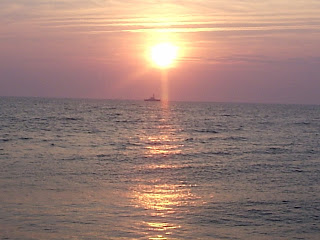
The Cape May Canal empties into the Delaware Bay about a mile from our place, the mouth lined by a rock jetty, courtesy of the Arm Corps of Engineers. The ferry to Delaware has a terminal here. There's a lovely park here, named after Patrolman David C. Douglass Sr., an officer killed in the line of duty in 1994.
Two stories, both witnessed on the jetty.
***
First story:
A young man with standard issue surfer trunks, the obligatory tattoo, and a young woman at his side, lifted a rock with two hands, held it over his head, then hurled it at his feet.
"Got it!"I wasn't sure what he "got" at first, but no denying his pride. His girlfriend smiled, but not all that impressed.
Turns out he was smashing "roaches," or so he thought. People share the jetty with isopods, crustaceans related to the roly-poly's you can find under a rock. (Some folks call roly poly's pill bugs, other call them potato bugs.)
The jetty isopods (Ligia exotica) have the misfortune to be known colloquially as wharf roaches. A lot of people don't like them.
Wharf roaches scattered at every footstep. These terrestrial isopods are fast and gruesome; a hundred of the filthy vermin skitter in your path, while another hundred shoot for cover in the crevices and cracks.So people kill them.James Card, freelance writer, quoted at his website
A Hispanic man was fishing with his children at his side, way at the end of the jetty, surrounded by water. He had hooked a horseshoe crab, and he was having difficulty trying to unhook it.
He did not know what it was. He was frightened, yet was gentle with the creature.
I came over to help. The horseshoe crab had swallowed the hook--the mouth was surrounded by lots of frantically waving legs with their tiny claws. Sky blue blood oozed from its wound.
Horseshoe crabs are harmless--I was able to untangle the line and remove the hook from the mortally injured critter.
The fisherman showed his children, then gently placed the crab back in the water.
His kindness towards something he feared reflected a sense of responsibility toward life I don't often see on the jetty.
***
I love to teach people about horseshoe crabs and sea slaters. Young children are more trusting than their elders, and it is often only after the youngest has held a horseshoe crab that older siblings will touch it.
I hope that my students are more likely to act like the 2nd man. I hope what I teach helps get them there.

No comments:
Post a Comment